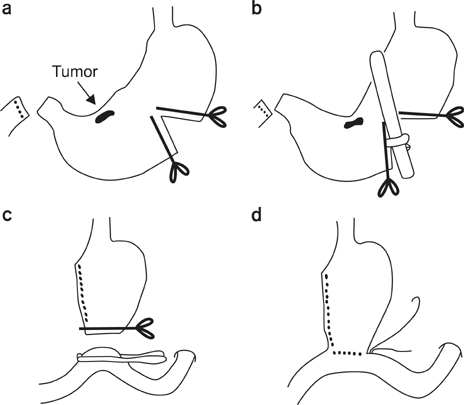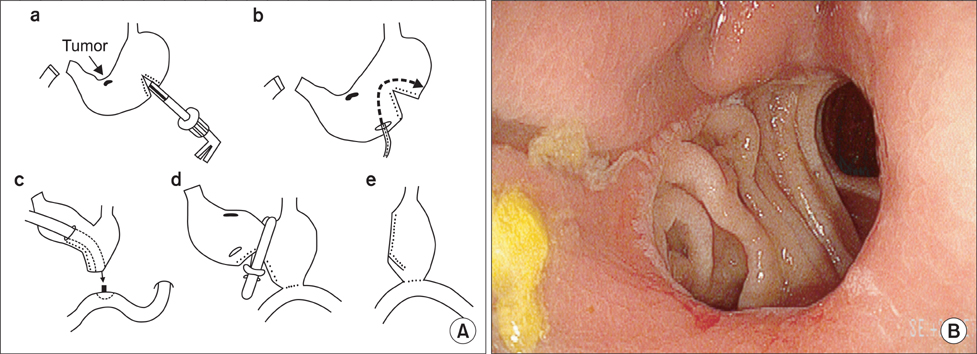J Gastric Cancer.
2012 Jun;12(2):120-125.
Comparative Study of Hand-Sutured versus Circular Stapled Anastomosis for Gastrojejunostomy in Laparoscopy Assisted Distal Gastrectomy
- Affiliations
-
- 1Department of Surgery, Dong-A University College of Medicine, Busan, Korea. sshamee@dau.ac.kr
Abstract
- PURPOSE
Mechanical stapler is regarded as a good alternative to the hand sewing technique, when used in gastric reconstruction. The circular stapling method has been widely applied to gastrectomy (open orlaparoscopic), for gastric cancer. We illustrated and compared the hand-sutured method to the circular stapling method, for Billroth-II, in patients who underwent laparoscopy assisted distal gastrectomy for gastric cancer.
MATERIALS AND METHODS
Between April 2009 and May 2011, 60 patients who underwent laparoscopy assisted distal gastrectomy, with Billroth-II, were enrolled. Hand-sutured Billroth-II was performed in 40 patients (manual group) and circular stapler Billroth-II was performed in 20 patients (stapler group). Clinicopathological features and post-operative outcomes were evaluated and compared between the two groups.
RESULTS
Nosignificant differences were observed in clinicopathologic parameters and post-operative outcomes, except in the operation times. Operation times and anastomosis times were significantly shorter in the stapler group (P=0.004 and P<0.001).
CONCLUSIONS
Compared to the hand-sutured method, the circular stapling method can be applied safely and more efficiently, when performing Billroth-II anastomosis, after laparoscopy assisted distal gastrectomy in patients with gastric cancer.
Keyword
Figure
Reference
-
1. Ohtsu A, Yoshida S, Saijo N. Disparities in gastric cancer chemotherapy between the East and West. J Clin Oncol. 2006. 24:2188–2196.
Article2. Hyung WJ, Kim SS, Choi WH, Cheong JH, Choi SH, Kim CB, et al. Changes in treatment outcomes of gastric cancer surgery over 45 years at a single institution. Yonsei Med J. 2008. 49:409–415.
Article3. Everett WG, Friend PJ, Forty J. Comparison of stapling and hand-suture for left-sided large bowel anastomosis. Br J Surg. 1986. 73:345–348.
Article4. Viste A, Haùgstvedt T, Eide GE, Søreide O. Postoperative complications and mortality after surgery for gastric cancer. Ann Surg. 1988. 207:7–13.
Article5. Kataoka M, Masaoka A, Hayashi S, Honda H, Hotta T, Niwa T, et al. Problems associated with the EEA stapling technique for esophagojejunostomy after total gastrectomy. Ann Surg. 1989. 209:99–104.
Article6. Arnaud JP, Ollier JC, Adloff M. A new procedure for Billroth-I anastomoses with the EEA stapler. Int Surg. 1983. 68:63–64.7. Nakane Y, Kanbara T, Michiura T, Inoue K, Iiyama H, Nakai K, et al. Billroth I gastrectomy using a circular stapler to treat gastric cancer. Surg Today. 2001. 31:90–92.
Article8. Hori S, Ochiai T, Gunji Y, Hayashi H, Suzuki T. A prospective randomized trial of hand-sutured versus mechanically stapled anastomoses for gastroduodenostomy after distal gastrectomy. Gastric Cancer. 2004. 7:24–30.
Article9. Yang HK, Lee HJ, Ahn HS, Yoo MW, Lee IK, Lee KU. Safety of modified double-stapling end-to-end gastroduodenostomy in distal subtotal gastrectomy. J Surg Oncol. 2007. 96:624–629.
Article10. An JY, Yoon SH, Pak KH, Heo GU, Oh SJ, Hyung WJ, et al. A novel modification of double stapling technique in Billroth I anastomosis. J Surg Oncol. 2009. 100:518–519.
Article11. Kim T, Yu W, Chung H. Handsewn versus stapled gastroduodenostomy in patients with gastric cancer: long-term follow-up of a randomized clinical trial. World J Surg. 2011. 35:1026–1029.
Article12. Weil PH, Scherz H. Comparison of stapled and hand-sutured gastrectomies. Arch Surg. 1981. 116:14–16.
Article13. el Ferzli G, Worth MH Jr. Direct anastomotic visualization in stapled Billroth II gastrectomy. Surg Gynecol Obstet. 1986. 163:487–488.14. Oh SJ, Hong JJ, Oh CA, Kim DH, Bae YS, Choi SH, et al. Stapling technique for performing Billroth II anastomosis after distal gastrectomy. J Gastrointest Surg. 2011. 15:1244–1246.
Article15. Edge SB, Byrd DR, Compton CC, Fritz AG, Greene FL, Trotti A, editors. AJCC Cancer Staging Manual. 2010. 7th ed. New York: Springer.16. Kim MC, Kim KH, Kim HH, Jung GJ. Comparison of laparoscopy-assisted by conventional open distal gastrectomy and extraperigastric lymph node dissection in early gastric cancer. J Surg Oncol. 2005. 91:90–94.
Article17. Ravitch MM, Steichen FM. A stapling instrument for end-to-end inverting anastomoses in the gastrointestinal tract. Ann Surg. 1979. 189:791–797.
Article18. Nance FC. New techniques of gastrointestinal anastomoses with the EEA stapler. Ann Surg. 1979. 189:587–600.
Article19. Walther BS, Oscarson JE, Graffner HO, Vallgren S, Evander A. Esophagojejunostomy with the EEA stapler. Surgery. 1986. 99:598–603.20. Paolini A, Tosato F, Cassese M, De Marchi C, Grande M, Paoletti P, et al. Total gastrectomy in the treatment of adenocarcinoma of the cardia. Review of the results in 73 resected patients. Am J Surg. 1986. 151:238–243.21. Habu H, Kando F, Saito N, Sato Y, Takeshita K, Sunagawa M, et al. Experience with the EEA stapler for esophagojejunostomy. Int Surg. 1989. 74:73–76.
- Full Text Links
- Actions
-
Cited
- CITED
-
- Close
- Share
- Similar articles
-
- Comparison of laparoscopy-assisted and totally laparoscopic Billroth-II distal gastrectomy for gastric cancer
- Circular Stapled Gastrojejunostomy after Radical Subtotal Gastrectomy: Anastomotic Bleeding and Prevention
- The Influence of Operative Approach on Food Retention after Open and Laparoscopy-Assisted Distal Gastrectomy (LADG) for Gastric Cancer
- Circular Stapled Billroth I Anastomosis after Distal Subtotal Gastrectomy : Anastomotic Complications and Prevention
- Intracorporeal Anastomosis in Laparoscopic Gastric Cancer Surgery



